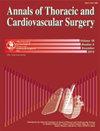急性A型主动脉夹层合并冠状动脉灌注不良手术中隐静脉移植物的瞬时血流测量
IF 1.3
4区 医学
Q4 CARDIAC & CARDIOVASCULAR SYSTEMS
引用次数: 0
摘要
目的:瞬时血流测量(TTFM)由脉搏指数(PI)、平均移植物流量和舒张充血组成,主要用于冠状动脉疾病(CAD)的旁路评估。然而,对冠状动脉灌注不良(CMP)的TTFM知之甚少。本研究旨在阐明两种不同疾病之间TTFM结果的差异。方法:2010年至2020年,138例患者接受了主动脉手术和冠状动脉旁路移植术(CABG)。患者分为两组:CMP (n = 26)和CAD (n = 27)。比较了他们的结果。主要终点是TTFM的结果。次要终点是各组TTFM与死亡率、发病率和短期通畅的关系。结果:CMP组PI明显高于对照组(4.7±2.9比3.4±1.9,p = 0.04)。其他两项差异无统计学意义。在两组中,除了心脏填塞外,短期移植物通畅、死亡率和发病率均未因TTFM结果而发生显著变化。结论:CMP患者PI高于CAD患者。对于主动脉夹层的额外冠脉搭桥,不充分的TTFM结果并不一定意味着短期移植物通畅不良、并发症或病例死亡率。本文章由计算机程序翻译,如有差异,请以英文原文为准。
Transit-Time Flow Measurement of Saphenous Vein Graft Used for Surgery of Acute Type A Aortic Dissection with Coronary Malperfusion
Purpose: Transit-time flow measurement (TTFM), consisting of pulsatility index (PI), mean graft flow, and diastolic filling, is mainly used as a bypass assessment for coronary artery disease (CAD). However, little was known about TTFM in the case of coronary malperfusion (CMP). This study aimed to clarify the difference in the results of TTFM between two different diseases. Methods: Between 2010 and 2020, 138 patients underwent aortic surgery and coronary artery bypass grafting (CABG) with vein grafts. Patients were divided into two groups: CMP (n = 26) and CAD (n = 27). Their results were compared. The primary endpoints were the results of TTFM. Secondary endpoints were the relation between TTFM and mortality, morbidity, and short-term patency in each group. Results: The PI in the CMP group was significantly higher than the other group (4.7 ± 2.9 vs. 3.4 ± 1.9, p = 0.04). There was no statistical significance in the other two elements. In both groups, the short-term graft patency, mortality, and morbidity but for cardiac tamponade did not significantly change depending on the TTFM results. Conclusions: Patients with CMP tended to have a higher PI than those with CAD. With additional CABG for aortic dissection, insufficient TTFM results did not necessarily mean poor short-term graft patency, complications, or case mortality.
求助全文
通过发布文献求助,成功后即可免费获取论文全文。
去求助
来源期刊

Annals of Thoracic and Cardiovascular Surgery
CARDIAC & CARDIOVASCULAR SYSTEMS-SURGERY
CiteScore
2.80
自引率
0.00%
发文量
56
审稿时长
4-8 weeks
期刊介绍:
Information not localized
 求助内容:
求助内容: 应助结果提醒方式:
应助结果提醒方式:


